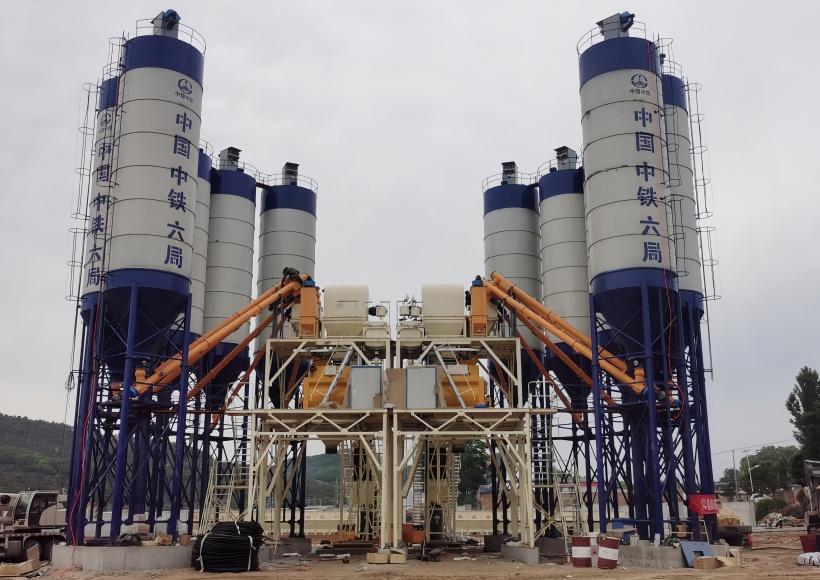Introduction: The Importance of Equipment Selection in Large-Scale Projects
In today’s era of rapid infrastructure development, the selection of concrete batching plants—as core equipment in construction projects—directly impacts project quality, progress, and economic efficiency. For large-scale projects, choosing a stable, appropriately sized, and highly efficient concrete batching plant is particularly critical. This article analyzes a practical case study of an HZS120 batching plant to explore key factors in equipment selection for large-scale projects, providing valuable insights for project decision-makers.
I. Analysis of Technical Features of HZS120 Batching Plant
1.1 Basic Parameters and Performance Advantages
The HZS120 batching plant, as a medium-to-large concrete production equipment, offers the following distinctive features:
- Theoretical Productivity: 120 m³/h
- Mixer Model: JS2000 Twin-Shaft Forced Mixer
- Batching Machine Model: 3200L (Four Independent Hoppers)
- Aggregate Storage Capacity: 4 × 20 m³
- Powder Storage Capacity: 4 × 100 t
- Control System: Fully Automated Microcomputer Control
Its modular design facilitates easier installation and relocation, making it particularly suitable for long-duration large-scale projects.
1.2 Core Technological Innovations
The HZS120 batching plant incorporates several technological innovations:
1. High-Efficiency Mixing System: Dual-spiral blade design ensures more uniform mixing and reduces mixing time by 15%.
2. Energy-Saving and Eco-Friendly Design: Fully enclosed structure with pulse dust removal system limits dust emissions to ≤20 mg/m³.
3. Intelligent Control System: Features remote monitoring, fault diagnosis, production data tracking, and ERP integration.
4. Wear-Resistance Technology: Key components use special wear-resistant materials, extending service life by 30%.

II. Key Considerations for Equipment Selection in Large-Scale Projects
2.1 Analysis of Project Requirements
During selection, the following project-specific requirements must be prioritized:
- Concrete Demand: Calculate hourly and daily concrete requirements based on total project volume and timeline.
- Concrete Types: Determine if special concretes (e.g., high-strength, fiber-reinforced, roller-compacted) are needed.
- Site Conditions: Include available space, terrain, and access to water and electricity.
- Environmental Requirements: Consider regional standards for noise and dust emissions.
For example, a highway project requiring 1,500 m³ of concrete daily over a 3-year period would be well-served by an HZS120 plant (with a daily output of ~1,800 m³ at 80% efficiency), providing both sufficiency and buffer capacity.
2.2 Economic Evaluation Model
A comprehensive economic evaluation model must include:
1. Initial Investment Costs: Equipment purchase, transportation, and installation.
2. Operational Costs: Power consumption, replacement of wear parts, labor.
3. Maintenance Costs: Regular servicing and major repairs.
4. Residual Value Assessment: Post-use equipment value.
The HZS120 plant demonstrated 18% lower total costs over 3 years compared to smaller equipment combinations and 35% lower initial investment than higher-capacity alternatives.
2.3 Supplier Capability Assessment
Key factors when selecting a supplier include:
- R&D Capability: Capacity for innovation and customization.
- Manufacturing Standards: Factory scale, production processes, quality control.
- After-Sales Service: Service network coverage, response time, spare parts availability.
- Project Experience: Successful cases in similar projects.
III. Practical Case Study of HZS120 Batching Plant
3.1 Case Background: A Cross-Sea Bridge Project
Project Overview:
- Project Type: Cross-sea bridge
- Total Concrete Volume: ~250,000 m³
- Peak Daily Demand: 1,500 m³
- Timeline: 40 months
- Environmental Conditions: High salinity, humidity, and typhoon exposure
3.2 Equipment Configuration
The finalized configuration included:
- Main Setup: Two HZS120 plants (one active, one standby)
- Additional Features:
- Anti-corrosion coating
- Dual-backup control system
- Wind resistance design for cement silos
3.3 Performance Evaluation
Operational results were exceptional:
- Productivity: Average output of 90 m³/h, reaching 1,800 m³ daily.
- Quality: 100% concrete strength compliance.
- Reliability: 92% operational utilization with <0.5% downtime.
- Cost Efficiency: ~15% savings on equipment-related costs versus budget.

IV. Common Pitfalls and Avoidance Strategies in Batching Plant Selection
4.1 Typical Selection Errors
- Bigger Is Better Fallacy: Over-sizing leads to underutilization and wasted investment.
- Price-Only Focus: Neglecting lifecycle costs for lower upfront expenses.
- Over-Configuration: Adding unnecessary features increases procurement costs.
- Ignoring Environmental Needs: Inadequate eco-investments result in higher retrofitting costs later.
4.2 Scientific Selection Methodology
Implement a systematic selection process:
- Precise Demand Analysis: Quantify concrete requirements per project phase.
- Multi-Option Comparison: Evaluate 3–5 feasible solutions comprehensively.
- Risk Assessment: Identify technical, economic, and environmental risks.
- Expert Review: Engage technical, economic, and construction experts for evaluation.
V. Future Trends in Batching Plant Technology
5.1 Intelligent Development
- ERP Integration: Manage material flow, production ratios, inventory, and data storage transparently.
5.2 Green Innovations
- Dust Control: Pulse dust collectors and silo spray systems.
- Recycling Systems: Sand-water separators enable 100% reuse of waste and water.
- Low-Noise Technology: Fully enclosed equipment and storage areas.
5.3 Modularization
Future plants will emphasize:
- Rapid Installation: Containerized modular designs.
Conclusion: Scientific Selection Creates Project Value
The HZS120 case study demonstrates that scientific equipment selection delivers significant technical and economic benefits for large-scale projects. Amidst China’s 14th Five-Year Plan emphasis on high-quality infrastructure, decision-makers should adopt a lifecycle cost perspective, balancing advanced technology, economic rationality, and operational reliability to choose concrete production equipment tailored to project needs. As intelligent construction and green practices advance, future selections will increasingly prioritize digital and smart features, maximizing value for engineering projects.